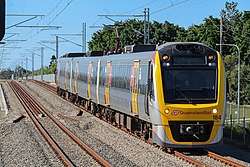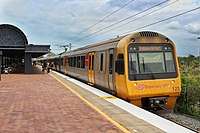Interurban multiple unit
The Interurban multiple units (IMU) are a class of electric multiple units manufactured by Walkers Limited/Downer EDI Rail, Maryborough for Queensland Rail's Citytrain division between 1996 and 2011. The IMU is divided into in three subclasses, sets 101-110 as the 100 series, sets 121-124 as the 120 series, and sets 161-188, as the 160 series.
| Interurban multiple unit | |
|---|---|
 an EDI/Bombardier IMU 160 Unit. | |
| Manufacturer | Walkers Limited Downer EDI Rail |
| Built at | Maryborough |
| Constructed | 1996-1997 (100) 2001-2002 (120) 2008-2011 (160) |
| Number built | 36 carriages (100) 12 carriages (120) 84 carriages (160) |
| Formation | 3 carriage sets |
| Fleet numbers | 101-110 (100) 121-124 (120) 161-188 (160) |
| Operator(s) | Queensland Rail |
| Specifications | |
| Train length | 72.4 m (237 ft 6 in) |
| Width | 2.7 m (8 ft 10 in) |
| Height | 3.9 m (12 ft 10 in) |
| Maximum speed | 140 km/h (87 mph) (100 & 120) 130 km/h (81 mph) (160) |
| Weight | 131.8 t (129.7 long tons; 145.3 short tons) (100) 130.4 t (128.3 long tons; 143.7 short tons) (120) 128.2 t (126.2 long tons; 141.3 short tons) (160) |
| Electric system(s) | 25 kV AC overhead lines |
| Current collection method | Pantograph |
| Coupling system | Scharfenberg Type 10 coupler |
| Track gauge | 1,067 mm (3 ft 6 in) |
Design
The Interurban Multiple Units are a long-distance optimised version of the Suburban Multiple Units. Internally, the IMUs differ from the SMUs, being fitted with larger seats, luggage racks and mobility-access toilets.[1] Like most trains in the Citytrain fleet, two three-car IMUs can be coupled to form one six-car set.
History

100 series
To provide rolling stock for the new Gold Coast line to Helensvale, in 1993 a contract for four 100 class sets was awarded to Walkers Limited, Maryborough. The 100 were manufactured by Walkers Limited, Maryborough in partnership with ABB. The first four IMU100s, 101 to 104 entered service in 1996 before the opening of the new line. As these were never going to be adequate to operate all services on the line, in July 1995 a further six were ordered. They were delivered in 1997.[2] They feature luggage racks, disabled access toilets, and high-backed cloth seating. IMU 105 still retains the green ocean themed seating moquette, which has been replaced in all other units. The only other train this design can be seen on is the ICE.

120 series
In 1999, four 120 series sets were ordered for the Airtrain line to Brisbane Airport.[3]
These are fitted with high-backed seats with a head cushion as an extension as the seat design is based on the SMU 220s, one toilet per unit and luggage racks in different configurations due to the interior design differences to its predecessor. The 100 series and 120 series are interoperable, and used to operate together in revenue service as six-car sets, but no longer do so due to electrical and mechanical differences.
The 120 series were the final batch of trains manufactured by Walkers Limited, before being absorbed by Downer Group, Maryborough in partnership with ADtranz which was likewise taken over by Bombardier.
The IMU120s entered service in 2001 and 2002.
160 series
In 2004, Queensland Rail ordered sixteen 160 series sets to provide extra rolling stock in conjunction with the upgrade and duplication of the Gold Coast line.[4] The 160 series were manufactured by Downer EDI Rail, Maryborough in partnership with Bombardier Transportation. These trains are identical in design to the Transperth B-series train, with alterations to the headlights to complement with the rest of the Citytrain fleet. These trains are interoperable with the 260 series Suburban Multiple Units as they have almost identical specifications.
In early 2007, during safety checks, it was discovered that air-conditioning units on the trains were 10 millimetres too wide for the loading gauge.[5]
On 28 May 2007, the first of the new IMUs entered service on the Gold Coast line.[6]
Most IMU160 services on the Gold Coast have been superseded by the faster New Generation Rollingstock.
Derailments
On 31 January 2013, IMU173 derailed at Cleveland station and ran into the station's toilet block, injuring 14. Only minor injuries were reported.[7] The damaged car IM5173 was eventually repaired and returned to service.
Notes
- "QROTI - Travel Information - Fleet - IMU". Archived from the original on 1 December 2008. Retrieved 30 March 2010.
- "Queensland's Interurban Multiple Units" Railway Digest October 1998 pages 26-28
- "Brisbane Airport Rail Link Go-Ahead" Railway Digest April 1999 page 15
- Downer EDI and Bombardier to supply rail cars to Queensland Rail under contract valued at $212M Downer Rail 2 November 2004
- Pavey, Ainsley (24 February 2007). "Bungle Halts Trains". The Courier-Mail. News Corp. Archived from the original on 11 August 2011.
- "Rail Funding to Get Budget Boost". Brisbane Times. 28 May 2007.
- Passenger train derails on Cleveland line during morning commute The Australian 1 February 2013
References
- ^ "New trains, new timetable". Queensland Government. 27 May 2007.
External links
| Wikimedia Commons has media related to QR IMU 100 series. |
| Wikimedia Commons has media related to IMU 160 series. |